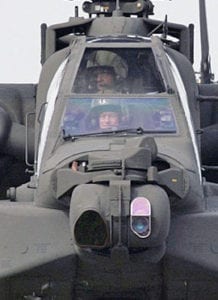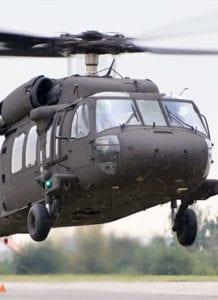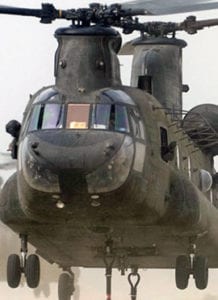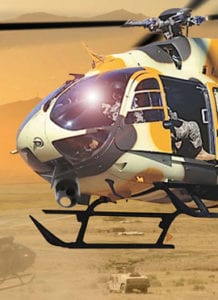
AH-64D/E APACHE

UH-60A/M BLACKHAWK

CH-47D/F CHINOOK

UH-72A LAKOTA

AH-64D/E APACHE

UH-60A/M BLACKHAWK

CH-47D/F CHINOOK

UH-72A LAKOTA
A Program of Record Since 1998
Apache TESS is used to safely train personnel in the tactical operations of the AH-64D/E Apache Attack Helicopter. Live training includes cooperative force engagements, evasive procedures, and the use of Aircraft Survivability Equipment (ASE). Player and Event data is transmitted in real-time for display and tracking on the Modular Mobile Command and Control (MMCC) to provide situational awareness, player-to-player communications, engagement adjudication, Real-Time Casualty Assessment (RTCA), and After Action Review (AAR).
Aviation TESS is comprised of an Aircraft System that integrates with range infrastructures, command and control, and ground target training systems.
Aviation TESS consists of an “A” kit that is permanently installed during aircraft production, and a “B” kit that is added to the aircraft for training exercises. The “A” kit includes the Advanced Smart Onboard Data Interface Module (ASMODIM) tray assembly and modified software in the weapons display and systems processors with cable connection provisions. The “B” kit includes the ASMODIM, TESS Gun Control Unit (TGCU), TESS Training Missile (TTM), and GPS and Telemetry antennas.
Live Fire training uses only the B-Kit “Back-half Kit” and provides real-time Position/Location and AAR.
Aviation TESS enables pilots to safely perform gunnery training without firing a round. Weapon systems acquire and engage TESS instrumented targets. TESS uses MILES Laser and Geometric Pairing to adjudicate all weapon engagements. SAL Missile and 30mm Gun engagements are simulated with MILES eye-safe lasers. RF Missile and Rocket engagements are simulated with Geometric Pairing. Pilots receive visual and audio cues in real-time.
The Training Laser Designator (TLD) is permanently embedded within the Modernized Day Sensor Assembly (M-DSA) for the M-TADS/PNVS. The TLD simulates weapon designation performed by tactical hardware. The TLD is a self-contained subsystem consisting of a collimated Class 3R (ANSI) 904 nanometer (nm) eye-safe Laser energy transmitter capable of transmitting MILES coded messages to simulate designation during training exercises. It includes the optics required to direct the laser beams and the associated electronics to drive the TLD. MILES output is enabled when firing simulated Hellfire Missiles or Rockets when Apache TESS is installed and engaged on the aircraft. Parameters for direct fire routine are in accordance with PMT 90-S002A. MILES Player IDs range up to 1320 unique Players and 4 Ammo codes.
The Advanced Smart Onboard Data Interface Module (ASMODIM)integrates with air and ground vehicles to provide weapons systems training and collective engagements. It interfaces electronically to the aircraft weapons systems to provide a training mode, weapons emulation, and a simulated weapons inventory. The ASMODIM computes MILES and Geometric Pairing algorithms for all Longbow weapon engagements. Exercise data is actively monitored, recorded and transmitted to the EXCON for analysis and AAR.
The ASMODIM is a replacement to the legacy Modular SMODIM due to parts obsolescence. It is fully backward compatible with Aviation TESS and includes increased processing capacity and performance and other capability improvements.
Collected Data includes:
The TESS Gun Control Unit (TGCU) includes a 904nm eye-safe Laser that transmits MILES Communications Weapon Codes for the 30mm Gun to simulate weapon engagements with TESS instrumented targets. It is mounted within the 30mm Gun Turret and receives commands from the aircraft to control the TGCU and TLD. 30mm gunfire is visually indicated to the target in single or multiple burst rates by the Flash Weapon Effects Signature Simulator (FlashWESS) when the aircraft weapons trigger is pulled. Pilots receive audio cues over the aircraft intercom.
The TESS Training Missile (TTM) mounts onto a pylon launcher and interfaces with the aircraft weapons processor to enable training mode and weapons emulation. The TTM replaces and emulates the Hellfire missile in size, shape and weight. A Flash Weapon Effects Signature Simulator (FlashWESS) provides visual signals of weapon firing events, and the Aircraft Kill Indicator (AKI) provides visual indication of RTCA status of the aircraft platform.
TASS replicates enemy Integrated Air Defense Systems (IADS) threats by providing interrogation, tracking and targeting of aircraft participating in combined arms Force-on-Force (FoF) training at the Combat Training Centers (CTCs). Incoming aircraft are detected by Opposing Force (OPFOR) acquisition systems. Launching platforms engage aircraft by stimulating the ASE B-Kit Emulator (ABE)*. The emulated ASE triggers the correct aural/audio/visual cues to aircrew, and monitors aircraft maneuvers, usage of terrain features, weapons and countermeasures inventories, usage and remaining stores.
TASS adjudicates the attack and relays status and performance parameters of the threat for display on the unclassified CTC-IS. At end-game, TASS presents the user with computed miss-distance and probability of hit/kill results to quantify the outcome of the engagement.
TASS-Virtual is an evolution of TASS, or TASS-V. TASS-V is a critical capability allowing aircrews to train ATM 2800-2900 series tasks to standard.
TASS-V enables users to be stimulated by virtual air defense threats anytime, anywhere, providing live, in-aircraft ASE emulations with or without tactical ASE B-Kit hardware, sensors or comparators installed. TASS-V can present realistic long range threats with the ability to detect aircraft beyond radio transmission range, hundreds of kilometers away. Like TASS, TASS-V uses the US Army ASE B-Kit Emulator (ABE)* Common Threat Database. TASS-V does not alter on-aircraft TASS hardware or software and can be operated under currently approved AWRs for UH60, CH47 and AH64 aircraft. This approach enables realistic, doctrinal Threat Integrated Air Defense System (T-IADS) arrays created by Users. Virtual threat scenarios can be created and loaded via COTS laptop running the TASS-V Threat Loader and relayed to the transmitting radio. Aircraft are searched, acquired, and engaged the same way TASS does today.
See attached brochure and pricing sheet:
* The ABE software (Government owned) was developed for PEO STRI, in conjunction with PM-ASE providing technical guidance.
The Training Man-Portable Air Defense System (T-MANPADS) is designed to simulate real world air defense threats against aviation platforms. It is a self-contained, shoulder launched, ground-to-air missile simulator that provides for cooperative engagements between air and ground platforms, while increasing the complexity and fidelity of Opposing Force (OPFOR) air defenses. The simulated threat challenges Aircrews and enables training of tasks associated with penetrating, disintegrating, and exploiting the Anti-Access and Area Denial Air Defense Systems at the Combat Training Centers (CTCs).
Utilizing technology from fielded Ground Threat Emitters (GTEs), the T-MANPADS is an aviation crew trainer for the currently fielded Training Aircraft Survivability Equipment (ASE) Stimulation Suite (TASS). Simulated offensive characteristics are controlled by the TASS Common Threat Database.
This air defense training system visually replicates a Threat MANPADS and includes smoke, light, noise, and weapon effects simulation. MILES Laser Detectors make it responsive to direct fire MILES laser engagements. A valid trigger pull resulting in a weapon launch causes an M176 Surface to Air Weapon Effects Signature Simulator (WESS) cartridge to detonate and provides visual indication to Pilots. Lethality Effect Assessment Routings (LEAR) is indicated visually by the System Kill Indicator (SKI) and audibly with a built-in alarm. Bluetooth connects to a Human Interface Device (HID) display that can overlay aim point and target lock symbology to enable training anytime, anywhere.
Universal Components for a Variety of Platforms
Aviation TESS (AV-TESS) instruments the UH-60 Blackhawk and CH-47 Chinook helicopters for collective training at U.S. Army Combat Training Centers (CTCs) and Home Stations. MILES Laser engagement capability is added by integrating the SMODIM, Aircraft Kill Indicator (AKI), and GPS and Telemetry Antennas. The AKI is a hermetically sealed, high-intensity strobe light that transmits standard “Hit”, “Kill” or “Near Miss” flash sequence indications when the Laser Sensors detect MILES Laser energy.
AV-TESS is designed to interface with the CTC’s Core Instrumentation System (CIS) through the existing Army Aviation Data Management System (AADMS) network. The SMODIM processes signals received from the Laser Sensors/Detectors to calculate Real-Time Casualty Assessment (RTCA). Based on the outcome, the SMODIM controls AKI signaling, injects audio messages through the aircraft Intercom System (ICS), and transmits event data through the telemetry network.
The Aviation MILES Detector Plate (AMDP) provides detection of 904nm MILES Laser engagements. Four assemblies per platform are installed to detect, identify and characterize MILES engagements. The MILES Sensors have a viewing window of 120°, 60° off the center line spherically. They are designed with a Built-In Test (BIT) capability and report BIT status to the SMODIM. AMDPs are installed and connected to the aircraft Laser Warning System when the aircraft does not have the AN/AVR-2 Laser Warning System installed. The Plate is installed in the same location as the AN/AVR-2.
Fielded to NTC, JRTC and JMRC Combat Training Centers
LUH-TESS provides dual capabilities for the UH-72A Lakota Light Utility Helicopter (LUH) to perform as an Observer/Controller (O/C) and Opposing Force (OPFOR). An Offensive Weapons Capability is added to provide target acquisition and simulated weapons for the OPFOR threat aircraft. Weapons are simulated with a MILES coded Laser. New platform integrated components include the Articulating Sensor Package (ASP) with embedded FlashWESS Laser Transmitter (FLT), Weapons Processor, Hand Controller and two Color Cockpit Displays.
The Articulating Sensor Package (ASP) interfaces to the existing LUH-TESS components and is mounted on the forward fuselage. The ASP provides day/night video and communicates with the Weapons Processor for target acquisition and engagements.
The FlashWESS Laser Transmitter (FLT) employs a 904nm MILES coded Laser that provides weapons simulation for missiles, rockets and 30mm cannon. The FLT is manufactured by ICE and embedded inside the MX-10 Surveillance Turret manufactured by L-3 WESCAM and includes an HD Electro-Optical (EO) Infrared (IR) surveillance camera and HD TV. The combined assembly is called the Articulating Sensor Package (ASP).
The Weapons Processor is the interface between the ASP and the LUH-TESS SMODIM. The Weapons Processor controls weapon events and interfaces with audio/video functions, ASP, and SMODIM. The Weapons Processor is packaged in a MIL-STD qualified enclosure and installed in the avionics bay.
The Hand Controller articulates the ASP and controls the zoom and focus of the internal camera.
A weapons trigger provides an offensive capability and indicates when the Laser is armed and active. Two Color Cockpit Displays provide situational awareness, targeting, weapon selection, rounds count, range and trigger pull.














